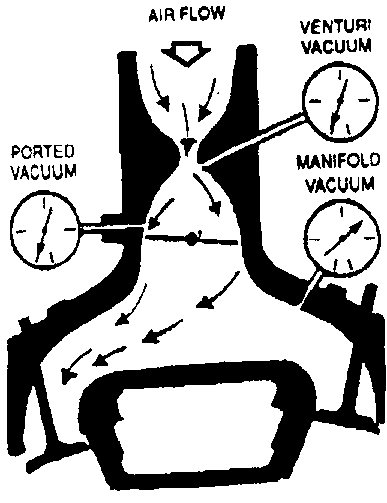http://www.centuryperformance.com/tunin ... g-148.html
http://www.earlycuda.org/tech/vacuum2.htm
How To Interpret Vacuum Gauge Readings
Contributed By: Gordon McKenzie
I'm using the Haynes Fuel Injection book as it seems to give the longest description of the readings. I doubt this is a copyright infringement as this is public knowledge, but I'll give them credit anyway as they put it together well.
Normal vacuum: All motors regardless of number of cylinders all have about the same vacuum. 15 to 20 inches of mercury (in-Hg) At wide open throttle (WOT) it will approach 0. On deceleration it can briefly go as high as 25 to 28 in-Hg. I think higher compression motors are at the high end while our big lumbering 360;s are middle to low end with 454's being the lowest. Don't quote me on that. For every 1000 feet above sea level, normal readings will drop 1 in-Hg
Cranking vacuum: 1-4 in-hg when cranking with the ignition disabled and throttle at WOT.
Operating vacuum: 15-20 in-Hg at idle. 19-21 in-Hg at steady 2500 rpm. About 0 at WOT. 25-28 while decelerating. In all cases the needle should be fairly steady.
Low stead reading: Leaking gasket carb base, leaky vacuum hose (biggest FSJ problem), late ignition timing or late crankshaft timing (jumped timing chain?)
Low fluctuating needle: Needle fluctuates three to eight inches below normal. Suspect a leak in the intake manifold gasket.
Regular drops: Two to four inch consistent drop. Likely a leaking valve. Perform a leakdown and compression check to isolate the bad valve.
Irregular drops: Two to four inch occasional drop. Sticking valve or ignition misfire. Do a leakdown and compression check as well as inspecting the plugs for fouling.
Rapid vibration: A rapid 4 in variation at idle combined with exhaust smoke indicate worn valve guide. Perform leakdown test to confirm. If rapid vibration occurs with an increase in engine speed, check for a leaking intake manifold gasket or head gasket, weak valve springs burned valve or ignition misfire.
Slight fluctuation: A slight 1 inch fluctuation may mean ignition problems Check all tune up items and try an ignition analyzer.
Large fluctuation: Perform compression or leakdown test to find a weak or dead cylinder or blown head gasket.
Slow Hunting: Needle moves slowly through a wide range. Check for clogged PCV, incorrect idle mixture or carb to manifold gasket leaks.
Slow return after revving: Snap throttle to WOT until engine at 2500 rpm. then release. Vacuum should drop to 0 then go to 25-28 then back down to normal. If vacuum returns slowly and doesn't peak the rings may be worn. If there is a long delay, look for a restricted exhaust. If the exhaust seems restricted, disconnect at manifold and repeat the now loud test
http://www.bob2000.com/carb.htm

vacuum gauges must be connected to manifold vacuum
http://garage.grumpysperformance.com/index.php?threads/carb-tuning-info-and-links.109/#post-44435
http://garage.grumpysperformance.com/index.php?threads/reading-spark-plugs.3949/
http://garage.grumpysperformance.com/index.php?threads/spark-plug-info.202/
https://www.harborfreight.com/fuel-pump-and-vacuum-tester-62637.html
http://www.secondchancegarage.com/public/186.cfm
http://garage.grumpysperformance.com/index.php?threads/vacuum-gauge-help.9453/#post-52071
http://garage.grumpysperformance.com/index.php?threads/vacuum-gauge-tunning-info.797/#post-1157
http://www.transcat.com/dwyer-instr...MI9Mq93bDY3gIVDP_jBx0y0gOzEAQYASABEgK54_D_BwE

http://www.earlycuda.org/tech/vacuum2.htm
How To Interpret Vacuum Gauge Readings
Contributed By: Gordon McKenzie
I'm using the Haynes Fuel Injection book as it seems to give the longest description of the readings. I doubt this is a copyright infringement as this is public knowledge, but I'll give them credit anyway as they put it together well.
Normal vacuum: All motors regardless of number of cylinders all have about the same vacuum. 15 to 20 inches of mercury (in-Hg) At wide open throttle (WOT) it will approach 0. On deceleration it can briefly go as high as 25 to 28 in-Hg. I think higher compression motors are at the high end while our big lumbering 360;s are middle to low end with 454's being the lowest. Don't quote me on that. For every 1000 feet above sea level, normal readings will drop 1 in-Hg
Cranking vacuum: 1-4 in-hg when cranking with the ignition disabled and throttle at WOT.
Operating vacuum: 15-20 in-Hg at idle. 19-21 in-Hg at steady 2500 rpm. About 0 at WOT. 25-28 while decelerating. In all cases the needle should be fairly steady.
Low stead reading: Leaking gasket carb base, leaky vacuum hose (biggest FSJ problem), late ignition timing or late crankshaft timing (jumped timing chain?)
Low fluctuating needle: Needle fluctuates three to eight inches below normal. Suspect a leak in the intake manifold gasket.
Regular drops: Two to four inch consistent drop. Likely a leaking valve. Perform a leakdown and compression check to isolate the bad valve.
Irregular drops: Two to four inch occasional drop. Sticking valve or ignition misfire. Do a leakdown and compression check as well as inspecting the plugs for fouling.
Rapid vibration: A rapid 4 in variation at idle combined with exhaust smoke indicate worn valve guide. Perform leakdown test to confirm. If rapid vibration occurs with an increase in engine speed, check for a leaking intake manifold gasket or head gasket, weak valve springs burned valve or ignition misfire.
Slight fluctuation: A slight 1 inch fluctuation may mean ignition problems Check all tune up items and try an ignition analyzer.
Large fluctuation: Perform compression or leakdown test to find a weak or dead cylinder or blown head gasket.
Slow Hunting: Needle moves slowly through a wide range. Check for clogged PCV, incorrect idle mixture or carb to manifold gasket leaks.
Slow return after revving: Snap throttle to WOT until engine at 2500 rpm. then release. Vacuum should drop to 0 then go to 25-28 then back down to normal. If vacuum returns slowly and doesn't peak the rings may be worn. If there is a long delay, look for a restricted exhaust. If the exhaust seems restricted, disconnect at manifold and repeat the now loud test
http://www.bob2000.com/carb.htm

vacuum gauges must be connected to manifold vacuum
http://garage.grumpysperformance.com/index.php?threads/carb-tuning-info-and-links.109/#post-44435
http://garage.grumpysperformance.com/index.php?threads/reading-spark-plugs.3949/
http://garage.grumpysperformance.com/index.php?threads/spark-plug-info.202/
https://www.harborfreight.com/fuel-pump-and-vacuum-tester-62637.html
http://www.secondchancegarage.com/public/186.cfm
http://garage.grumpysperformance.com/index.php?threads/vacuum-gauge-help.9453/#post-52071
http://garage.grumpysperformance.com/index.php?threads/vacuum-gauge-tunning-info.797/#post-1157
http://www.transcat.com/dwyer-instr...MI9Mq93bDY3gIVDP_jBx0y0gOzEAQYASABEgK54_D_BwE

Last edited by a moderator:
